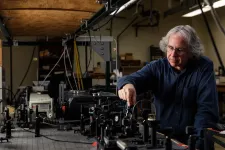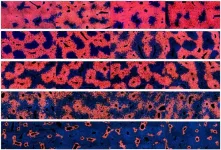What might sheep and driverless cars have in common? Following the herd
Researchers show how social component of moral decision-making can influence programming of autonomous vehicles and other technologies
2021-02-25
(Press-News.org) Psychologists have long found that people behave differently than when they learn of peers' actions. A new study by computer scientists found that when individuals in an experiment about autonomous vehicles were informed that their peers were more likely to sacrifice their own safety to program their vehicle to hit a wall rather than hit pedestrians who were at risk, the percentage of individuals willing to sacrifice their own safety increased by approximately two-thirds.
As computer scientists train machines to act as people's agents in all sorts of situations, the study's authors indicate that the social component of decision-making is often overlooked. This could be of great consequence, note the paper's authors who show that the trolly problem -long shown to be the scenario moral psychologists turn to--is problematic. The problem, the authors indicate, fails to show the complexity of how humans make decisions.
Jonathan Gratch, one of the paper's author, the principal investigator for this project, and a computer scientist at the USC Institute for Creative Technologies, says existing models assume that in high stakes life and death decisions, people think differently than they actually do. He indicates that there are not moral absolutes for human decision-making but rather "it is more nuanced," says Gratch.
The researchers conducted four separate simulation experiments to understand how people might process and act on the moral dilemmas they would face as an operator of a driverless car. The first three experiments focused on human behavior when faced with risk to themselves and others in the event of negative scenario in which the vehicle would have to be programmed to either the car to hit the wall or hit five pedestrians. The authors prove that participants would use severity of injury to self and the risk to others as guideposts for decision-making. They found that the higher the risk to pedestrians; the more likely people were likely to self -sacrifice their own health. In addition, the level of risk to pedestrians did not to have to be as high as for the operator of the autonomous vehicle to sacrifice their own well-being.
In the fourth experiment, the researchers added a social dimension telling participants what peers had opted to do in the same situation. In one simulation, the knowledge that peers chose to risk their own health changed the participants' responses, rising from 30 percent who were willing to risk their health to 50 percent. But this can go both ways cautions Gratch. "Technically there are two forces at work. When people realize their peers don't care, this pulls people down to selfishness. When they realize they care, this pulls them up."
The research has implications for autonomous vehicles including drones and boats, as well as robots that are programmed by humans. The authors suggest that it is important for manufacturers to have an awareness of how humans actually make decisions in life or death situations. In addition, the authors imply that transparency in how machines are programmed as well as relinquishing controls to the human drivers so that they might change settings prior to these life and death situations are important for the public. They also suggest it is important for legislators to be aware of how vehicles might be programmed. Lastly, given the human susceptibility to conform to social norms, the authors believe that public health campaigns related to how peers programmed their autonomous vehicles for self-sacrifice might influence future owners to change their vehicle settings to be more oriented to protecting others from injury and choose self-sacrifice.
INFORMATION:
The authors of this study are Celso M. de Melo of the US Army Research Laboratory, Stacy Marsella of Northeastern University, and Jonathan Gratch of the USC Institute for Creative Studies.
ELSE PRESS RELEASES FROM THIS DATE:
2021-02-25
States regularly use administrative records, such as motor-vehicle data, in determining whether people have moved to prune their voter rolls. A Yale-led study of this process in Wisconsin shows that a significant percentage of registered voters are incorrectly identified as having changed addresses, potentially endangering their right to vote.
The study, published in the journal Science Advances, found that at least 4% of people listed as suspected "movers" cast ballots in 2018 elections using addresses that were wrongly flagged as out of date. Minority voters were twice as likely as white voters to cast their ...
2021-02-25
The COVID-19 virus holds some mysteries. Scientists remain in the dark on aspects of how it fuses and enters the host cell; how it assembles itself; and how it buds off the host cell.
Computational modeling combined with experimental data provides insights into these behaviors. But modeling over meaningful timescales of the pandemic-causing SARS-CoV-2 virus has so far been limited to just its pieces like the spike protein, a target for the current round of vaccines.
A new multiscale coarse-grained model of the complete SARS-CoV-2 virion, its core genetic material and virion shell, has been developed for the first time using supercomputers. The model offers ...
2021-02-25
Litter is not only a problem on Earth. According to NASA, there are currently millions of pieces of space junk in the range of altitudes from 200 to 2,000 kilometers above the Earth's surface, which is known as low Earth orbit (LEO). Most of the junk is comprised of objects created by humans, like pieces of old spacecraft or defunct satellites. This space debris can reach speeds of up to 18,000 miles per hour, posing a major danger to the 2,612 satellites that currently operate at LEO. Without effective tools for tracking space debris, parts of LEO may even become too hazardous for satellites.
In a paper publishing today in the SIAM Journal on Imaging Sciences, Matan Leibovich (New York University), George Papanicolaou (Stanford University), and Chrysoula Tsogka (University of California, ...
2021-02-25
The unprecedented cost of the 2018 Kilauea eruption in Hawai'i reflects the intersection of distinct physical and social phenomena: infrequent, highly destructive eruptions, and atypically high population growth, according to a new study published in Nature Communications and led by University of Hawai'i at Mānoa researchers.
It has long been recognized that areas in Puna, Hawai'i, are at high risk from lava flows. This ensured that land values were lower in Puna--which lies within the three highest risk lava hazard zones 1, 2 and 3--which actively promoted rapid population ...
2021-02-25
Our body consists of 100 trillion cells that communicate with each other, receive signals from the outside world and react to them. A central role in this communication network is attributed to receiver proteins, called receptors, which are anchored at the cell membrane. There, they receive and transmit signals to the inside of the cell, where a cell reaction is triggered.
In humans, G protein-coupled receptors (GPC receptors) represent the largest group of these receptor molecules, with around 700 different types. The research of the Frankfurt and Leipzig scientists focused on a GPC receptor that serves as a receptor for the ...
2021-02-25
Timothy Callaghan, PhD, and Alva Ferdinand, DrPH, JD, from the Southwest Rural Health Research Center at Texas A&M University School of Public Health, joined colleagues in the first national study of how often people in urban and rural areas in the United States follow COVID-19 guidelines. These include public health best practices like wearing masks in public, sanitizing homes and work areas, maintaining physical distancing, working from home and avoiding dining in restaurants or bars.
The research team used a survey of 5,009 U.S. adults that closely matched the makeup of the country's population as a whole. The survey asked how often participants followed COVID-19 prevention recommendations and collected data on political ideology, perceived risk ...
2021-02-25
ITHACA, N.Y. - A team from Cornell University's Environmental Systems Lab, led by recent graduate Allison Bernett, has put forth a new framework for injecting as much information as possible into the pre-design and early design phases of a project, potentially saving architects and design teams time and money down the road.
"(Our framework) allows designers to understand the full environmental impact of their building," said Bernett, corresponding author of "Sustainability Evaluation for Early Design (SEED) Framework for Energy Use, Embodied Carbon, Cost, and Daylighting Assessment" which published Jan. 10 in the Journal of ...
2021-02-25
WEST LAFAYETTE, Ind. -- Doppler radar improves lives by peeking inside air masses to predict the weather. A Purdue University team is using similar technology to look inside living cells, introducing a method to detect pathogens and treat infections in ways that scientists never have before.
In a new study, the team used Doppler to sneak a peek inside cells and track their metabolic activity in real time, without having to wait for cultures to grow. Using this ability, the researchers can test microbes found in food, water, and other environments to see if they are pathogens, or help them identify the right medicine to treat antibiotic-resistant bacteria.
David Nolte, Purdue's Edward ...
2021-02-25
HOUSTON - (Feb. 25, 2021) - Low-income livestock farmers in developing countries are often faced with a difficult dilemma: protect their animals from endangered predators, or spare the threatened species at the expense of their livestock and livelihood.
A new paper by Rice University economist Ted Loch-Temzelides examines such circumstances faced by farmers in Pakistan. "Conservation, risk aversion, and livestock insurance: The case of the snow leopard" outlines a plan under which farmers can protect themselves from crippling financial losses while ...
2021-02-25
While the amazing regenerative power of the liver has been known since ancient times, the cells responsible for maintaining and replenishing the liver have remained a mystery. Now, research from the Children's Medical Center Research Institute at UT Southwestern (CRI) has identified the cells responsible for liver maintenance and regeneration while also pinpointing where they reside in the liver.
These findings, reported today in Science, could help scientists answer important questions about liver maintenance, liver damage (such as from fatty liver or alcoholic liver disease), and liver cancer.
The liver performs vital functions, including chemical detoxification, blood protein production, bile excretion, and regulation of energy metabolism. Structurally, the liver ...
LAST 30 PRESS RELEASES:
[Press-News.org] What might sheep and driverless cars have in common? Following the herd
Researchers show how social component of moral decision-making can influence programming of autonomous vehicles and other technologies



